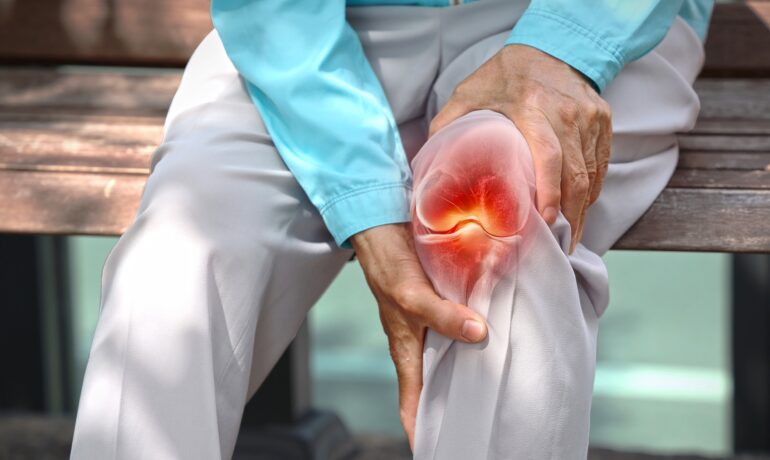Flare-ups don’t happen on a schedule, and they can catch you off guard. Some days, symptoms are manageable, while other days, they suddenly intensify without warning and bring on heightened pain, stiffness, and fatigue that interfere with even the simplest tasks. But learning to recognize the signs and understanding why they occur can make all the difference in how you manage them.
What Is an Osteoarthritis Flare-Up?
An osteoarthritis flare-up is a temporary period when joint symptoms become more severe than usual. These flares can come on gradually or appear suddenly, and they can last for days or even weeks. While the exact cause of a flare is not always clear, they often follow increased joint strain, changes in weather, or shifts in activity levels.1
Unlike the steady background discomfort many people with osteoarthritis experience, flare-ups represent an acute worsening of symptoms. Pain becomes sharper, stiffness increases, and swelling may appear.
Common Symptoms of an Osteoarthritis Flare
During a flare, symptoms intensify, creating a cycle that can feel overwhelming. Here are the most frequent signs to watch for:
- Increased Joint Pain: Pain often spikes during flares, becoming more localized and harder to ignore. This discomfort can be sharp or throbbing, affecting mobility and sleep.2
- Stiffness and Reduced Range of Motion: Morning stiffness may last longer, and joints may feel locked or restricted, making it harder to bend, stretch, or move freely.3
- Swelling Around the Joint: Inflammation can cause visible puffiness, warmth, or tenderness in affected joints, contributing to both pain and limited function.1
- Tenderness to Touch: Even light pressure on a joint may feel uncomfortable during a flare. This heightened sensitivity can make daily tasks more challenging.4
- Functional Limitations: Routine activities such as climbing stairs, opening jars, or walking short distances may suddenly feel strenuous or impossible.5
- Emotional Impact: Increased pain and loss of independence during flares can contribute to frustration, irritability, or sadness, which in turn may worsen the perception of pain.6
Recognizing these symptoms early can help you take steps to rest, adjust activities, and seek care when needed.
Why Do Osteoarthritis Flares Happen?
Osteoarthritis flares occur for several reasons, and often more than one factor is involved. Knowing these triggers may help you take preventive measures:
- Joint Overuse: Extra strain from heavy lifting, repetitive movements, or sudden increases in activity can irritate already sensitive joints.1
- Changes in Weather or Temperature: Many patients report flares when humidity rises, temperatures drop, or barometric pressure shifts, although science is still exploring why these changes impact joints.1
- Stress and Fatigue: Stress doesn’t just affect the mind — it can influence the body’s inflammatory response, increasing pain and fatigue during a flare.
- Weight Gain: Additional weight puts extra pressure on joints, especially knees and hips, which can trigger more intense pain episodes.7
- Secondary Injuries or Conditions: Sprains, falls, or other joint injuries can spark a flare. Co-existing health issues, like diabetes or poor circulation, may also make symptoms worse.1
Understanding these triggers allows patients to work with their doctors to create strategies for prevention and management tailored to their lifestyle.
How Long Do Flare-Ups Last?
The duration of an osteoarthritis flare-up can vary from person to person. Some people may only experience a day or two of heightened discomfort, while others might feel the effects for several weeks. The length often depends on factors such as overall joint health, the presence of other medical conditions, and how quickly treatment is applied.
How to Manage Symptoms During a Flare
Managing flare-ups often requires a combination of self-care strategies and medical guidance. Resting the affected joint is crucial, but complete inactivity should be avoided, as it can lead to stiffness and muscle weakness. Gentle stretching, low-impact exercise, or physical therapy can help maintain flexibility during recovery.8
Some patients also find relief through lifestyle adjustments such as maintaining a healthy weight, practicing stress management techniques, and following a balanced diet. Always check with your physician before starting or changing any treatment plan to ensure it’s safe for your individual needs.
Talk to a Rheumatologist About Your Osteoarthritis Flare-Ups
If flare-ups are becoming more frequent or harder to manage, it may be time to consult an ARBDA rheumatologist in New Jersey. Our physicians specialize in diagnosing and treating arthritis and related conditions, giving you a personalized care plan. A rheumatologist can assess your current symptoms, evaluate disease progression, and recommend treatments to help reduce pain and improve joint function.
It’s important to first speak with your primary care doctor about your symptoms. If they agree that a specialist visit would be beneficial, ARBDA offers comprehensive rheumatology care across multiple New Jersey locations. Our team of experienced osteoarthritis doctors is committed to helping patients manage flare-ups effectively, restore mobility, and regain control of their daily lives. Fill out a new patient contact form today to get started!
1https://pmc.ncbi.nlm.nih.gov/articles/PMC10444473/
2https://pmc.ncbi.nlm.nih.gov/articles/PMC4641239/
3https://www.rheumatologyadvisor.com/features/limited-mobility-caused-by-oa-impacts-mental-health/
4https://www.mayoclinic.org/diseases-conditions/osteoarthritis/symptoms-causes/syc-20351925
5https://pmc.ncbi.nlm.nih.gov/articles/PMC6658279/
6https://pmc.ncbi.nlm.nih.gov/articles/PMC8883119/

